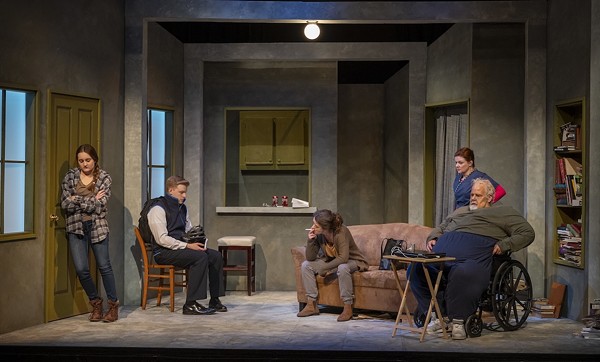Entertainment
The Whale Is a Bittersweet Story of Loneliness, Longing and Regret

On the surface, Samuel D. Hunter’s The Whale can be interpreted as an indictment of excess and selfishness. Dive in a little deeper, however, and you will find a poignant examination of love, death, loss and despair that’s deeply personal and affecting. In St. Louis Actors’ Studio’s finely wrought production, director Annamaria Pileggi and a talented cast mine those depths, finding connection in loneliness and compassion in sorrow.
After abandoning his relationship with his wife and young child and losing his lover, Charlie has become isolated and obese, eating his way to an early death. He teaches English composition remotely, with his camera off so his students can’t see him, and his only visitor is his friend Liz, a health care professional and sister to Charlie’s deceased lover. She both indulges his voracious appetite for junk food and provides the best care she can since Charlie refuses to go to the hospital. After a teenage Mormon with troubles of his own helps him survive a potentially fatal episode, Charlie reaches out to his daughter and bribes her to visit. He also invites the young missionary to come back to talk at another time. Eventually, as Charlie attempts to get his life in some sort of order before he dies, his daughter’s mother joins the mix.
William Roth turns in one of his best performances as Charlie, convincingly conveying the character’s difficulties moving and breathing while also showing the deep emotional scars and lingering pain that contribute to his current condition. Roth deftly captures a heaviness that has nothing to do with Charlie’s weight but that’s perhaps keeping him from moving forward or making changes that may extend his life.
Colleen Backer is heartbreaking as his friend and caregiver Liz, channeling her own loss into Charlie’s care then collapsing in inconsolable grief when she realizes she’s likely going to lose him. Lizi Watt is neurotic yet supportive as Charlie’s alcoholic ex-wife, a women desperately trying to hang on even as she feels her grip slipping. Nadja Kapetanovich and Thomas Patrick Riley as Charlie’s angry daughter Ellie and the proselytizing Elder Thomas elicit genuine sympathy and pathos through their portrayals. Flawed characters searching for a reason to change their ways, the bond the three form provides slivers of hope while allowing Charlie the chance to reveal the wells of concern and empathy that may be all that keep him alive.
The whale referenced in the title is not simply Charlie’s corpulent physique, but also a clever and effective incorporation of literature and the Bible in ways that are symbolic and relevant to Charlie. Though this is not a happy story, these allusions contribute to a unique sense of acceptance and reassurance that envelops the play. In this way, The Whale elicits a surprising tenderness that avoids despair, choosing instead to embrace dignity and human kindness among characters one might avoid if given the chance. Smart stagecraft, particularly Kristi Gunther’s omnipresent sound and Patrick Huber’s subtle lighting, and insightful guidance by director Pileggi reveal a nuanced complexity to the characters and message. Filled with surprising depth and unexpected, at times poorly conveyed grace, The Whale is a satisfying, quietly comforting story that mature audiences will likely enjoy, even if it elicits a tear or two in sympathy.
Subscribe to Riverfront Times newsletters.
Follow us: Apple News | Google News | NewsBreak | Reddit | Instagram | Facebook | Twitter | Or sign up for our RSS Feed
Entertainment
OK, That New Cardinals/Nelly City Connect Collab Is Kind of Great

When did St. Louis start feeling so down in the dumps? Maybe the malaise started during COVID and just never lifted? Maybe we could blame Kim Gardner, or all those teeth-rattling potholes? The Cardinals’ ongoing slump sure hasn’t helped. For whatever reason, the municipal mood has been sour for awhile — and seems to show no signs of lightening.And yet today, two icons gave us a reason to smile, or at least remember better times. Hey, if we’ve been there before, maybe we can get there again? The occasion was the roll-out of of the Cardinals’ new City Connect jersey, which you could file under Yet Another Major League Baseball Money Grab, but we’ll instead choose to think of as a Nike-led attempt to offer an alternative to each ballclub’s classic jerseys, something that doesn’t just work on the field but also reflects each MLB city’s culture. They’ve been rolling these out city by city, and it’s fair to say some are better than others. Cleveland? Don’t get us started. The New York Mets? Fit for flushing. The Cardinals’ iteration strikes us as much better than most, perhaps because the team started with such a great uniform in the first place. You can’t go wrong with those glorious Cardinals and that crimson red. click to enlarge Yes, it’s a money grab, but as far as money grabs go, we like them. But even more than the jersey, we really like the video launching the City Connect uniforms, which stars none other than Nelly and seems to capture a St. Louis that feels more real, and more admirable, than many promotions of its ilk.Yes, the video includes some already overplayed greatest hits (at some point, we have to stop letting toasted ravioli be so central to our civic identity). But there are some nice turns of phrase (“A city built to brew, and destined to deliver” and “where the grammar is a little bit street and a little bit country” are both spot-on). And who doesn’t thrill to see the Arch under construction — or true neighborhood spots like Donut Drive-In and the 1860s Hard Shell Saloon?We’re from The Lou and we’re proud.#ForTheLou pic.twitter.com/ynvewkn5Aa— St. Louis Cardinals (@Cardinals) May 20, 2024
Could this be the collaboration to lift us out of our malaise? Undoubtedly not; we’ve got more to fix around here than any 2-minute video ever could, no matter the star power behind it. And we suspect the Cardinals will have to start winning for it to truly start feeling like the heyday of “Country Grammar” again. But it’s great to see a project that didn’t result in a swing and a miss. And it’s also good to be reminded that for all the things that don’t work in St. Louis, we have a lot to be proud of — and damn good donuts and live music and our sports obsession to help us get by. We’re from the Lou, and today, we’re proud.
Subscribe to Riverfront Times newsletters.Follow us: Apple News | Google News | NewsBreak | Reddit | Instagram | Facebook | Twitter | Or sign up for our RSS Feed
Source link
Entertainment
Cicadas Are What’s for Dinner — But One Bug Lover Isn’t Happy

Last Friday, the Missouri Botanical Garden did something sure to shock the conscience of every good St. Louisan: They served up cicadas.The cicada scampi and spicy deep-fried cicada — yes, those were the actual dish names — were part of an cooking demonstration at MoBOT’s Sophia M. Sachs Butterfly House, a fun afternoon inspired by the cicadapocalypse now blanketing a big swath of St. Louis County with the long-gestating bugs.But not everyone found the idea so fun. In fact, one local put it upon themselves to try to stop the culinary demonstration. In a series of emails forwarded to the RFT by one of the many (many!) people CCed on them, this lone cicada warrior sought to make the case that eating bugs was beyond the pale — not because they’re gross, but because they can feel pain just like any living creature. “I’d do anything to stop this awful destruction of our nature,” wrote the anonymous advocate. “They aren’t bothering me or anyone bc I don’t bother them and nobody else will unless we have manager of Butterfly House insisting on a cruel needless heartless eating them event. Cicadas are chill they like trees [sic], they’re like frogs croaking you just live with it they’re talking mating that’s nature coexist [sic] and they just here for a minute.” The writer added, “The cicadas are not insignificant they have such amazing process of thoughts and feelings I have pulled out from dog water bowl couple times and you see their appreciation they have the most tight amazing little grip with their teeny claws like he held on and they look right at you. They are beautiful intricate.” We’re not sure we’d use “beautiful” to describe the little buggers, but de gustibus non est disputandum. And we’ll grant the cicada-loving activist this: They certainly do have short life spans.Asked about the potential controversy, MoBOT spokeswoman Catherine Martin told us on Friday they have not heard from others who feel the same way. She also notes that MoBOT took steps to shield the insect ingredients from pain: “Cicadas will be euthanized humanely before being cooked. The team will collect the cicadas and put them in a freezer. Since they are cold-blooded animals, the freezer temperature causes them to fall asleep and then pass away without pain. We never cook cicadas while they are still alive.” Would that lobsters could say the same! It’s worth noting that factory farming causes far more pain to animals that are far more sentient than cicadas (and, obviously, some people have made it their life’s work to try to stop those practices). Some animal lovers have suggested insects may be a better solution than, say, our current practices involving chickens. Notes Martin, “Eating insects is a common practice worldwide. The UN estimates that 2 billion people routinely eating insects, and humans consume more than 1,900 species of insects as food. Insects as human food provide protein, vitamins and minerals and are vastly more sustainable than other animal protein sources.” One last note while we consider the cicada: If you’re allergic to shellfish, you may well be allergic to these insects, too, since they are in fact closely related. Forget their “teeny claws” — that might be a great reason to proceed with caution towards that supper of cicada scampi.
Subscribe to Riverfront Times newsletters.Follow us: Apple News | Google News | NewsBreak | Reddit | Instagram | Facebook | Twitter | Or sign up for our RSS Feed
Entertainment
How Bob Cassilly Saved Michaelangelo’s Pietà

Bob Cassilly played a profound role in reshaping the look and feel of St. Louis. The sculptor turned curator and creator of City Museum, Turtle Park, and many other beloved local installations remains one of St. Louis’ most esteemed residents more than a decade after his tragic death in 2011.
But before Cassilly became a visionary for a new urban landscape, he played just as significant a role in preserving one of the world’s most beloved masterpieces, Michaelangelo’s sculpture Pietà. While the media covered the incident at the time, it’s become a forgotten chapter in Cassilly’s remarkable life.
Named with the Italian word for “pity,” the Pietà depicts Mary cradling the body of Jesus in the aftermath of the crucifixion. Erected by Michaelangelo in 1498 and 1499, it was installed at St. Peter’s Basilica in Vatican City in the 1600s and has spent most of its days there ever since, becoming one of the world’s most venerated works of art.
On May 21, 1972, Cassilly and his new bride were visiting St. Peter’s Basilica in Vatican City as part of their honeymoon, an old-fashioned grand tour of Europe, he told the St. Louis Post-Dispatch. As they approached Pieta, Cassilly saw a man with a long beard climb onto the sculpture. The man reportedly screamed about Jesus Christ and started desecrating the statue, smashing at Mary’s face and removing her hand with an implement that proved to be a geologist’s hammer, a fearsome tool with a long chisel head.
The man, Laszlo Toth, was a mentally ill Hungarian-born geologist who recently moved to Rome from Australia. According to reports by the Associated Press, Toth believed himself to be Jesus Christ and said that Mary was not his real mother.
click to enlarge Bystanders drag Laszlo Toth (right) away from the Pieta in St. Peters after he smashed it with a hammer. This photo was released by the Vatican the following day.
Cassilly was the first person to rush Toth and start to restrain him. He climbed the statue and grabbed at Toth’s beard. Cassilly punched Toth and brought his destruction to an end. “I leaped up and grabbed the guy by the beard,” Cassilly later told People Magazine. “We both fell into the crowd of screaming Italians. It was somewhat of a scene.” The young man from St. Louis’ courage inspired others to take down the hammer-wielding vandal.
Cassilly, Toth, and the others involved in the incident walked away with a few bruises, but the statue had suffered significant damage, both to Mary’s face and her left hand. Preservationists worked for years to restore Pietà to its original glory. The statue now sits in St. Peter’s Basilica behind bulletproof glass.
Toth was not charged with a crime but instead committed to a psychiatric hospital for two years. The Guardian reported that Toth later moved back to eastern Australia and lived in obscurity until his death in 2012.
Cassilly returned to St. Louis and opened a restaurant in Lafayette Park called Park Place, which he sold in 1978. Slowly but surely, he started earning commissions as a sculptor and began putting his own playful, historically-minded touches on the city’s landscape.
While Cassilly’s role in saving Pietà is surprisingly little known, it serves as an interesting and, in some ways, unsurprising footnote to his life’s work, which was seemingly forward looking and backward looking at the same time.
Subscribe to Riverfront Times newsletters.Follow us: Apple News | Google News | NewsBreak | Reddit | Instagram | Facebook | Twitter | Or sign up for our RSS Feed
-

 Entertainment1 year ago
Entertainment1 year agoSt.Louis Man Sounds Just Like Whitley Hewsten, Plans on Performing At The Shayfitz Arena.
-

 Business1 year ago
Business1 year agoWe Live Here Auténtico! | The Hispanic Chamber | Community and Connection Central
-
Board Bills1 year ago
2022-2023 Board Bill 189 — Public Works and Improvement Program at the Airport
-

 Local News1 year ago
Local News1 year agoVIDEO: St. Louis Visitor Has Meltdown on TikTok Over Gunshots
-

 News1 year ago
News1 year agoTed Lasso-inspired pop-up bar now open in St. Louis
-

 Board Bills1 year ago
Board Bills1 year ago2022-2023 Board Bill 165 — Jefferson Arms Community Improvement District
-
Board Bills1 year ago
2022-2023 Board Bill 183 — Amending Ordinance Number 62885 known as the Capital Improvements Sales Tax
-

 News10 months ago
News10 months agoGas tanker crashes into St. Louis Metro transit center





